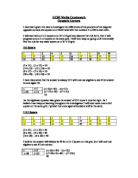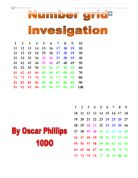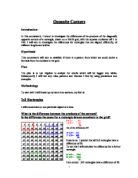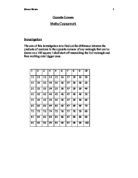opposite corners
GCSE Maths Coursework Opposite Corners I have been given the task to investigate the differences of the products of the diagonal opposite corners of a square on a 10x10 Grid with the numbers 1 to 100 to start with. I will start with a 2 x 2 square on a 10 x 10 grid and discover the rule for it, then I will progress onto a 3 x 3 square on the same grid. I will then keep on going until I eventually find the rule for any sized square on a 10 x 10 grid. 2x2 Square 2 3 4 5 6 7 8 9 0 1 2 3 4 5 6 7 8 9 20 21 22 23 24 25 26 27 28 29 30 (2 x 11) - (1 x 12) = 10 (14 x 25) - (15 x 24) = 10 (8 x 17) - (7 x 18) = 10 (20 x 29) - (19 x 30) = 10 I have discovered that the answer is always 10 I will now use algebra to see if the answer is once again 10. n n+1 n+10 n+11 (n+1)(n+10) - n(n+11) (n2+11n+10) - (n2+11n) 0 As the algebraic equation also gives the answer of 10 I know it must be right. As I believe I can keep on learning throughout the investigation I will now move onto a 3x3 square on the same grid. I predict that once again all answers will be the same. 3 X 3 Square 2 3 4 5 6 7 8 9 0 1 2 3 4 5 6 7 8 9 20 21 22 23 24 25 26 27 28 29 30 (3 x 21) - (1 x 23) = 40 (6 x 24) - (4 x 26) = 40 (10 x 28) - (8 x 30) = 40 I believe the answer will always be 40 for a 3 x 3 square on this grid. So I will now use algebra
Number grids. In this investigation I have been attempting to work out a formula that will find the difference between the products of the top left and bottom right of a number grid and the top right and bottom left of a number grid.
2 3 4 5 6 7 8 9 0 1 2 3 4 5 6 7 8 9 20 21 22 23 24 25 26 27 28 29 30 31 32 33 34 35 36 37 38 39 40 41 42 43 44 45 46 47 48 49 50 51 52 53 54 55 56 57 58 59 60 61 62 63 64 65 66 67 68 69 70 71 72 73 74 75 76 77 78 79 80 81 82 83 84 85 86 87 88 89 90 91 92 93 94 95 96 97 98 99 00 2 3 4 5 6 7 8 9 0 1 2 3 4 5 6 7 8 9 20 21 22 23 24 25 26 27 28 29 30 31 32 33 34 35 36 37 38 39 40 41 42 43 44 45 46 47 48 49 50 51 52 53 54 55 56 57 58 59 60 61 62 63 64 65 66 67 68 69 70 71 72 73 74 75 76 77 78 79 80 81 In this investigation I have been attempting to work out a formula that will find the difference between the products of the top left and bottom right of a number grid and the top right and bottom left of a number grid. 2 3 4 5 6 7 8 9 0 1 2 3 4 5 6 7 8 9 20 21 22 23 24 25 26 27 28 29 30 31 32 33 34 35 36 37 38 39 40 41 42 43 44 45 46 47 48 49 50 51 52 53 54 55 56 57 58 59 60 61 62 63 64 65 66 67 68 69 70 71 72 73 74 75 76 77 78 79 80 81 82 83 84 85 86 87 88 89 90 91 92 93 94 95 96 97 98 99 00 A 10x10 number grid If you choose any 2x2 box on a 10x10 number grid then the difference should equal 10...
I am going to investigate the difference between the products of the numbers in the opposite corners of any rectangle that can be drawn on a 100 square (10x10) grid
Opposite Corners Opposite Corners * Throughout this piece of work, the horizontal side will be referred to as the length, whilst the vertical side will be referred to as width. Introduction/Aim I am going to investigate the difference between the products of the numbers in the opposite corners of any rectangle that can be drawn on a 100 square (10x10) grid. I am going to investigate different rectangles, of different areas, lengths, widths and positioning on a grid. After finding a pattern, I will try and prove that it will work for other cases by using algebra and making an algebraic formula. As I go along, I will have to record any ideas I have or patterns I see. Afterwards, I will go on to investigate how this rule may differs on a different sized grid. 2x2 Square, 10x10 Grid 2 3 4 5 6 7 8 9 10 11 12 13 14 15 16 17 18 19 20 21 22 23 24 25 26 27 28 29 30 31 32 33 34 35 36 37 38 39 40 41 42 43 44 45 46 47 48 49 50 51 52 53 54 55 56 57 58 59 60 61 62 63 64 65 66 67 68 69 70 71 72 73 74 75 76 77 78 79 80 81 82 83 84 85 86 87 88 89 90 91 92 93 94 95 96 97 98 99 100 This is a 10x10 grid. On it (outlines in red) is a 2x2 square. Firstly, I’m going to see what the difference between the products of the corners is (D): 55x64=3520 54x65= 3510 3520-3510=10, D=10 Now: What
Opposite Corners
Opposite corners 1 2 3 4 5 6 7 8 9 10 11 12 13 14 15 16 17 18 19 20 21 22 23 24 25 26 27 28 29 30 31 32 33 34 35 36 37 38 39 40 41 42 43 44 45 46 47 48 49 50 51 52 53 54 55 56 57 58 59 60 61 62 63 64 65 66 67 68 69 70 71 72 73 74 75 76 77 78 79 80 81 82 83 84 85 86 87 88 89 90 91 92 93 94 95 96 97 98 99 00 On a 10*10 square grid, choose any 2*2 square, multiply the corners in that grid and then find the difference between the two corners investigate. 2 13 12 13 16 17 16 17 22 23 * 23 * 22 26 27 * 27 * 26 276 284 332 342 284-276=10 342-332=10 Difference=10 The two answers are the same. I think it would be the same for any 2*2 square. To prove this I will use algebra to show that in any 2*2 square the difference will 10. z- number in the top left corner z z+1 z(z+11)=z²+11z z+10z+11 (z+1)(z+10)=z²+11z+10 (z²+11z+10)-(z²+11z)=10 Difference = 10 This proves that with any 2*2 square the corners multiplied then subtracted always = 10 To further my investigations I am now going to
Opposite Corners. In this coursework, to find a formula from a set of numbers with different square sizes in opposite corners is the aim. The discovery of the formula will help in finding solutions to the tasks ahead as well as patterns involving Opposite
Introduction: The mathematical investigations that are about to be undertaken are all under one puzzle called Opposite Corners. In this coursework, to find a formula from a set of numbers with different square sizes in opposite corners is the aim. The discovery of the formula will help in finding solutions to the tasks ahead as well as patterns involving Opposite Corners. There are a few basic procedures to follow to achieve a basic understanding of the whole puzzle. A box consisting of numbers from 1 to 100, a 10 by 10 grid (arranged in a regular pattern) will aid in initiating an understanding for this piece. Procedure: . Place borders of four lines in order to enclose numbers arranged in a given grid. The enclosed numbers should form a perfect square. 2. Multiply the numbers that are found diagonally opposite and placed in the four corners of the box. 3. From the products obtained after multiplying, find the difference between them. An example is demonstrated on the next page. Below is a 10 by 10 grid. Here the numbers are arranged in 10 columns. 2 3 4 5 6 7 8 9 0 1 2 3 4 5 6 7 8 9 20 21 22 23 24 25 26 27 28 29 30 31 32 33 34 35 36 37 38 39 40 41 42 43 44 45 46 47 48 49 50 51 52 53 54 55 56 57 58 59 60 61 62 63 64 65 66 67 68 69 70 71 72 73 74 75 76 77 78 79 80 81 82 83 84 85
I am going to investigate by taking a square shape of numbers from a grid, and then I multiply the opposite corners to find the difference of these two results. Firstly I am going to start with a 10x10 grid
Gcse Math's - number grid coursework I am going to investigate by taking a square shape of numbers from a grid, and then I multiply the opposite corners to find the difference of these two results. Firstly I am going to start with a 10x10 grid and pick up 4 different squares, I will start with the 2x2 square. Then I move on and use the 3x3, 4x4 and the 5x5 square. number Left corner x right corner Right corner x left corner Products difference 3x24=312 4x23=322 0 2 4x25=350 5x24=360 0 3 25x36=900 26x35=910 0 I have noticed that the products difference of 2x2 squares in a 10x10 grid equal to 10. I predict if I move the 2x2 square to the right or down I will get the same answer. 4 34x45=1530 35x44=1540 0 My prediction is right. I am going to use algebra to test my results. n n+1 n+10 n+11 (n+1)(n+10)=n²+10+11n n(n+11)=n²+11n Products difference is equal to (n²+10+11n) - (n²+11n) =10 In the same grid I will now work out a 3x3 square. number Left corner x right corner Right corner x left corner Products difference 5 5x37=555 7x35=595 40 6 6x24=144 4x26=104 40 7 6x38=608 8x36=648 40 I have noticed that the products difference of 3x3 squares in a 10x10 grid equal to 40. I predict if I move the 3x3 square to the right or up I will get the same answer. 8 26x48=1248 28x46=1288 40 My prediction is right. I am going to
In this piece course work I am going to investigate opposite corners in grids
Mathematics Course Work Opposite Corners Introduction In this piece course work I am going to investigate opposite corners in grids. I will start by investigating a 7x7 grid. Within this grid I will use 2x2, 3x3, 4x4, 5x5, 6x6 and a 7x7 grid. I will do this to find whether I can find a pattern. I will do this by multiplying the two opposite corners together then subtracting them. I will try to find the patterns and do a formula that will work for all grid sizes and shapes. I will experiment shapes and sizes of all different grids. Prediction I predict that in a 7x7 grid all the opposite corners will be a multiple of 7 and in an 8x8 grid they will be a multiple of 8 and so on. They will only do this if I multiply the two opposite corners then subtract the two from each other. To check my hypothesis I will use 6x6, 7x7, 8x8 and maybe if I have time I will do a 9x9 and 10x10 grid. Also I will be looking at all different shapes and sizes. I hope to find a formula for all grids and all shapes and sizes. 7x7 Grid Here is a grid of numbers in sevens. It is called a seven grid. In this section I will multiply the opposite corners and then subtract them. 2x2 2 3 4 5 6 7 8 9 0 1 2 3 4 5 6 7 8 9 20 21 22 23 24 25 26 27 28 29 30 31 32 33 34 35 36 37 38 39 40 41 42 43 44 45 46 47 48 49 In my 7x7 grid I have highlighted three 2x2
In this coursework, I intend to investigate the differences of the products of the diagonally opposite corners of a rectangle, drawn on a 10x10 grid, with the squares numbered off 1 to 100
Opposite Corners Introduction In this coursework, I intend to investigate the differences of the products of the diagonally opposite corners of a rectangle, drawn on a 10x10 grid, with the squares numbered off 1 to 100. I will aim to investigate the differences for rectangles that are aligned differently, of different lengths and widths. Hypothesis This coursework will aim to establish if there is a pattern from which we could derive a formula from the numbers in the grid. Plan The plan is to use Algebra to analyse the results which will be logged into tables. Subsequently I will test any rules, patterns and theories I find by using predictions and examples. Methodology To start with I will break up my work into sections, my first is: 2x3 Rectangles I will concentrate on one particular aspect at a time. What is the difference between the products of the corners? Is the difference the same for a rectangle drawn anywhere in the grid? I now have several questions: Is the difference different when the rectangle is aligned so that its shortest sides are at the top and bottom? What is the same between the two alignments? What About Other Sizes of Rectangles? I will now try rectangles, all in the 2 x X series, with different lengths. I think I can now safely assume that the difference is always constant in relation to the size of the rectangle, therefore I only
Opposite Corners
Opposite Corners Maths Coursework Investigation The aim of this investigation is to find out the difference between the products of numbers in the opposite corners of any rectangle that can be drawn on a 100 square. I shall start off researching the 2x3 rectangle and then working onto bigger ones. 2 3 4 5 6 7 8 9 0 1 2 3 4 5 6 7 8 9 20 21 22 23 24 25 26 27 28 29 30 31 32 33 34 35 36 37 38 39 40 41 42 43 44 45 46 47 48 49 50 51 52 53 54 55 56 57 58 59 60 61 62 63 64 65 66 67 68 69 70 71 72 73 74 75 76 77 78 79 80 81 82 83 84 85 86 87 88 89 90 91 92 93 94 95 96 97 98 99 00 2x3 Rectangle 7 8 9 7 8 9 2 3 1 2 3 88 89 90 98 99 00 x13=13 88x100=8800 7x19=133 1x3=33 98x90=8820 17x9=153 20 20 20 Prediction I predict that when I multiply a 2x3 rectangle the opposite corners will have a difference of 20. 2x2 Rectangle (square) 72 73 82 83 4 5 4 5 33 34 43 44 4x15=60 33x44=1452
Mathematics Coursework: problem solving tasks
My name is.....................; I am currently attending the ................ Amongst the various subjects I am undertaking this year, is GCSE mathematics. My coursework assignment asks that I seek to stipulate a formula that will help me establish exactly the required amount of spacers necessary for different arrangements of tiles. I feel the use of diagrams will be useful to depict different arrangements of tiles. Only from these arrangements, will I then be able to collect related information which will then assist me to compile a set of results. Subsequently; I will then organize my results systematically in table form and hopefully from this table I will become aware of a pattern beginning to form. Once I recognize this pattern, I can then determine a suitable formula as a way to work out the required amount of spacers needed for each tile arrangement without having to draw out all diagrams manually. A formula is a rule written in symbols and letters. Spacers are used when tiling a wall, to make sure the tiles are evenly spaced in straight lines, and that the grout between the tiles is of even thickness. Three types of spacers are used when tiling a wall, these include; * T spacer * + spacers & * L spacers My Prediction 'The L shape spacers required for each tile arrangement will always be 4' Results Table I made a table to show my results in a clear way

















